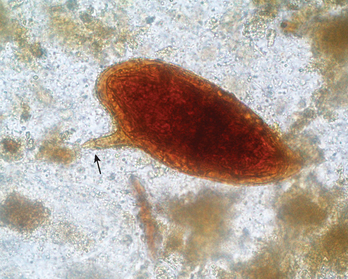CASE 52
A 41-year-old man presented with a 4-month history of worsening abdominal pain, diarrhea, nausea, and vomiting with blood. His abdominal pain was mainly in his right upper quadrant.
The man had recently immigrated to the United States from Kenya.
LABORATORY STUDIES
Diagnostic Work-Up
Table 52-1 lists the likely causes of the man’s illness (differential diagnosis). Diarrheal stool specimens may be positive for blood. Routine enteric investigation may be a good start to rule out enteric bacterial causes of diarrhea; however, further investigation for specific microbiologic diagnosis may include
TABLE 52-1 Differential Diagnosis and Rationale for Inclusion (consideration)
Rationale: In a person from a superendemic area, infectious gastroenteritis must always be considered. Diarrhea is very common and is not very useful by itself for narrowing the differential diagnosis. Other symptoms, such as hepatosplenomegaly, are helpful because most common causes of diarrhea do not lead to this complication. Schistosomiasis is one of the causes that should be considered; it is very common in endemic areas. Typhoid fever is always a consideration in patients with fever and abdominal pain who have recently been in a developing country. Acute viral hepatitis should be considered in patients who have fever and right-upper-quadrant pain, although hematemesis would not be expected.
MICROBIOLOGIC PROPERTIES
Schistosomiasis is caused by blood trematodes. The three main species infecting humans are Schistosoma haematobium, Schistosoma japonicum, and Schistosoma mansoni. S. haematobium lives in the venous plexus near the urinary bladder and ureters; S mansoni lives in the inferior mesenteric vein; and S. japonicum lives in the superior mesenteric vein of both the large and small intestines. Adult worms are small, 12 to 26 mm long and 0.3 to 0.6 mm wide (male and female remain paired together), varying with the different species. Adult worms mate and lay eggs. Identification of parasite eggs in stool is the most practical method for diagnosing schistosomiasis (should be requested). Size of eggs and the location of the spine (characteristic of schistosomal eggs) are useful in diagnosis of species (Fig. 52-1).
Stay updated, free articles. Join our Telegram channel

Full access? Get Clinical Tree



